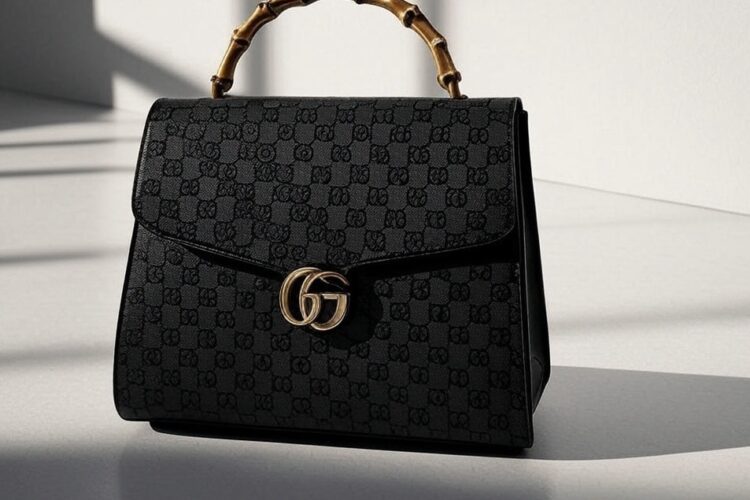Gucci, a leading Italian luxury fashion brand, blends heritage and innovation since its 1921 founding by Guccio Gucci in Florence. Known for high-end handbags like Dionysus and Marmont, iconic Horsebit loafers, and GG logo designs, Gucci defines style with artisanal craftsmanship. Creative directors like Tom Ford, Alessandro Michele, and Sabato De Sarno have shaped its bold, eclectic, and minimalist aesthetics. Owned by Kering, Gucci drives trends via Milan Fashion Week, celebrity endorsements, and Met Gala sponsorships. Its sustainability efforts, like Gucci Equilibrium, and digital ventures, including NFTs, keep it modern. Despite counterfeits, Gucci’s legacy in apparel, accessories, and fragrances like Gucci Bloom ensures its global influence.
Long Version
Gucci, an iconic name synonymous with luxury, has defined Italian fashion for nearly a century. As a cornerstone of high-end couture, Gucci blends artisanal craftsmanship, bold aesthetics, and cultural relevance to maintain its status as a global leader in the fashion industry. From its heritage rooted in Florence to its modern-day influence on runways, red carpets, and streetwear, Gucci’s journey is a testament to innovation, reinvention, and timeless glamour. This article explores every facet of Gucci—its history, design philosophy, key figures, product lines, cultural impact, and future trajectory—offering a comprehensive resource for enthusiasts and scholars of fashion.
The Origins: A Legacy of Craftsmanship
Founded in 1921 by Guccio Gucci in Florence, Italy, Gucci began as a small leather goods shop specializing in luggage and equestrian accessories. The brand’s early success stemmed from its Made in Italy ethos, emphasizing meticulous craftsmanship and premium materials. The iconic Bamboo handle, introduced in the 1940s due to wartime material shortages, became a hallmark of Gucci’s ingenuity, transforming scarcity into a symbol of elegance. Similarly, the Horsebit—inspired by equestrian motifs—adorned loafers and bags, embedding Gucci’s heritage into its designs.
The Gucci family, including Guccio’s sons Aldo and Rodolfo, expanded the brand globally, opening boutiques in New York, Paris, and beyond. However, internal family disputes, notably involving Maurizio Gucci, led to turbulent decades. The 1990s marked a turning point when Gucci was acquired by Kering (then PPR), a French luxury conglomerate, setting the stage for its modern renaissance.
The Tom Ford Era: Redefining Glamour
In 1994, Tom Ford became Gucci’s creative director, ushering in a bold, provocative aesthetic that revitalized the brand. Ford’s designs—sleek, sensual, and unapologetically glamorous—catered to the era’s jet-set elite. His collections featured monochromatic silk dresses, velvet suits, and the iconic Horsebit loafers, which became red carpet staples. Ford’s campaigns, dripping with sex appeal, positioned Gucci as a cultural force, attracting celebrity endorsements from Madonna to Gwyneth Paltrow.
Ford’s tenure also saw the rise of vintage Gucci as a collector’s obsession. Items like the Flora print scarf, originally designed for Grace Kelly, and the Double G monogram bag gained cult status in the resale market. By 2004, when Ford departed, Gucci had transformed from a struggling heritage brand into a $3 billion powerhouse.
Frida Giannini and the Transition
Frida Giannini, creative director from 2006 to 2014, brought a softer, more romantic vision to Gucci. Her collections emphasized ready-to-wear and accessories, with the Dionysus and Marmont bag lines becoming instant classics. Giannini leaned into Gucci’s archives, reviving the Flora print and introducing feminine silhouettes. However, her tenure faced criticism for lacking the bold innovation of Ford’s era, prompting Kering to seek a new direction.
The Alessandro Michele Revolution: Maximalism and Eclecticism
In 2015, Alessandro Michele, a relatively unknown accessories designer, was appointed creative director, sparking Gucci’s most transformative chapter. Michele’s aesthetic—eclectic, baroque, and unapologetically maximalist—redefined luxury fashion. His collections blended retro influences with modern streetwear, featuring oversized glasses, embroidered jackets, and vibrant prints. The GG logo was reimagined as a bold statement, adorning everything from sneakers to silk scarves.
Michele’s Gucci embraced inclusivity and individuality, resonating with a younger, diverse audience. Campaigns featured non-traditional models, and collaborations with brands like Adidas and Balenciaga blurred the lines between high fashion and pop culture. The Gucci Vault, an online platform curating vintage pieces and emerging designers, further cemented the brand’s forward-thinking ethos.
Michele also championed sustainability through Gucci Equilibrium, an initiative promoting eco-friendly materials and circular fashion. The Chime for Change campaign, launched in 2013 but amplified under Michele, advocated for gender equality, aligning Gucci with social impact.
Key products from Michele’s era include:
- Dionysus Bag: Known for its tiger-head clasp, inspired by Greek mythology.
- Ace Sneakers: Minimalist yet iconic, often customized with embroidery.
- Gucci Bloom: A bestselling perfume capturing the brand’s floral heritage.
- Gucci Osteria: A Michelin-starred restaurant in Florence, blending fashion with culinary arts.
Michele’s influence extended beyond fashion. His sponsorship of the Met Gala and designs for films like House of Gucci (2021), which chronicled the brand’s dramatic history, embedded Gucci in pop culture. By 2022, when Michele stepped down, Gucci’s revenue had soared to €9.7 billion, a testament to his visionary leadership.
Sabato De Sarno: A New Chapter of Minimalism
In 2023, Sabato De Sarno took the helm as creative director, introducing a more restrained, minimalist aesthetic. De Sarno’s debut collection, showcased at Milan Fashion Week, featured clean lines, tailored silhouettes, and a refined color palette. While a departure from Michele’s maximalism, De Sarno’s vision honors Gucci’s heritage, reinterpreting classics like the Bamboo bag and Horsebit loafers with modern elegance.
De Sarno’s approach targets a sophisticated clientele seeking timeless luxury. His lookbooks emphasize versatility, blending haute couture with everyday wear. Early reviews praise his ability to balance Gucci’s legacy with contemporary relevance, though some fans of Michele’s exuberance remain skeptical.
Gucci’s Product Empire: From Handbags to Digital Fashion
Gucci’s product portfolio spans apparel, accessories, and lifestyle categories, each reflecting its commitment to quality and innovation.
Handbags
Gucci’s handbags are among its most coveted offerings. The Dionysus, Marmont, and Bamboo lines combine functionality with artistry, featuring premium leathers and signature hardware. The Gucci Vault offers exclusive and vintage bags, catering to collectors.
Footwear
From the Horsebit loafers to the chunky Rhyton sneakers, Gucci’s footwear blends classic and contemporary. The Ace sneaker, with its customizable embroidery, remains a streetwear favorite.
Apparel
Gucci’s ready-to-wear collections range from tailored suits to bohemian dresses. Michele’s gender-fluid designs and De Sarno’s structured elegance showcase the brand’s versatility.
Accessories
Sunglasses, belts, and silk scarves—often adorned with the Flora print or Double G monogram—are staples in Gucci’s accessory lineup. The brand’s jewelry and watches exude understated luxury.
Fragrances
Perfumes like Gucci Guilty and Gucci Bloom capture the brand’s sensory allure, blending floral, woody, and musky notes.
Digital Ventures
Gucci has embraced digital fashion, launching NFTs and virtual collections on platforms like Roblox. These initiatives target Gen Z and reflect Gucci’s adaptability in a tech-driven world.
Cultural Impact: From Runway to Red Carpet
Gucci’s influence transcends fashion, shaping culture through celebrity endorsements, film, and social movements. Stars like Harry Styles, Rihanna, and Zendaya frequently wear Gucci on red carpets, while collaborations with artists like Billie Eilish amplify its relevance. The Met Gala, often sponsored by Gucci, showcases the brand’s ability to set trends.
The 2021 film House of Gucci, starring Lady Gaga as Patrizia Reggiani, brought the brand’s tumultuous history to the mainstream. While dramatized, the film highlighted Gucci’s legacy and the intrigue surrounding the Gucci family.
Gucci’s Chime for Change and sustainability efforts position it as a socially conscious brand. By addressing gender equality and environmental challenges, Gucci aligns luxury with purpose, appealing to ethically minded consumers.
Challenges: Counterfeits and Competition
Despite its success, Gucci faces challenges. The counterfeit market, fueled by the brand’s iconic GG logo, remains a persistent issue, with fake bags and accessories flooding online marketplaces. Gucci combats this through legal action and authentication services.
Competition from rivals like Louis Vuitton, Chanel, and emerging streetwear brands tests Gucci’s dominance. De Sarno’s minimalist pivot aims to differentiate Gucci in a crowded market, but maintaining relevance across demographics is a delicate balance.
The Future of Gucci
Under Sabato De Sarno and CEO Marco Bizzarri, Gucci is poised for continued evolution. Kering’s investment in sustainability and digital innovation ensures the brand remains at the forefront of luxury. The Gucci Garden and Gucci Museo in Florence celebrate its heritage, while global boutiques and e-commerce platforms drive accessibility.
As Gucci approaches its centennial, its ability to blend tradition with modernity—whether through artisanal craftsmanship, bold campaigns, or digital fashion—secures its place as a cultural and commercial titan. Whether you’re drawn to the Bamboo bag’s elegance, the Dionysus bag’s mythology, or the Ace sneaker’s street cred, Gucci offers something for every fashion devotee.
Hashtags For Social Media
#gucci #guccifashion #luxuryfashion #italianstyle #guccistyle #fashionicon #gucciaddict #highendfashion #guccilovers #designerfashion #guccivibes #fashionweek #milanfashionweek #gucciss25 #gucciistante #mfw #guccicouture #guccielegance #styleinspo #fashionforward #gucciglam #luxurylifestyle #gucciluxury #trendsetter #fashionista #guccicollection #runwayfashion #guccidesign #fashiongoals #guccitrend
Related Questions, Words, Phrases
gucci fashion brand overview | what is gucci known for | history of gucci | gucci luxury fashion impact | who founded gucci | gucci gg logo meaning | gucci horsebit loafers details | gucci dionysus bag features | gucci marmont bag popularity | gucci bamboo handle origin | gucci flora print history | gucci under alessandro michele | tom ford gucci era | gucci creative directors timeline | gucci kering ownership | gucci sustainability efforts | gucci equilibrium initiative | gucci chime for change campaign | gucci met gala sponsorship | gucci celebrity endorsements | gucci streetwear influence | gucci collaborations with adidas | gucci milan fashion week | gucci vintage pieces value | gucci resale market trends | gucci counterfeit issues | gucci digital fashion nfts | gucci perfume gucci bloom | gucci osteria restaurant | gucci vault platform | gucci minimalism under sabato de sarno | gucci heritage and legacy | gucci family drama | gucci pop culture influence | gucci fashion week trends






